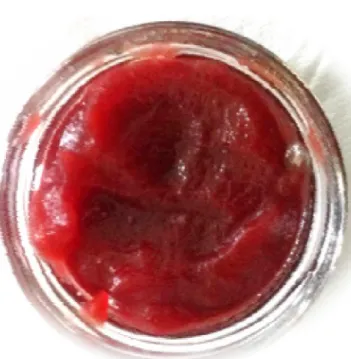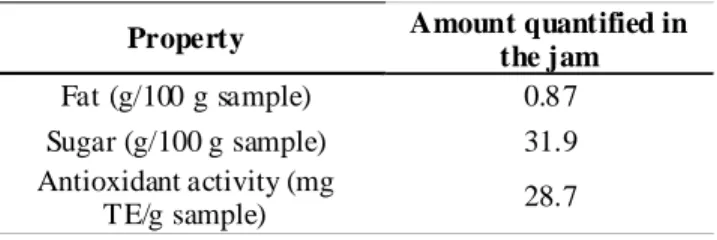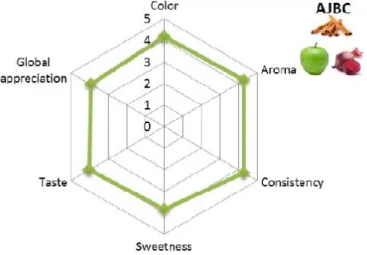Development of an innovative jam based on beetroot
Raquel P.F.Guiné1,2*, Ana R.F.Roque1, Fernando Gonçalves1,2, Paula M.R.Correia1,2 1Dep. Indústrias Alimentares, ESAV, Instituto Politécnico de Viseu, (PORTUGAL)
2CI&DETS/ESAV, Instituto Politécnico de Viseu, (PORTUGAL)
E-mail: raquelguine@esav.ipv.pt Antioxidant activity; Chemical properties; Product development; Sensorial analysis; Total phenols.
KEYWORDS
ABSTRACT
The objective of the present work was to develop an innovative food prod-uct with nutritional properties as well as appealing organoleptic quali-ties. For this a jam was prepared on a basis of pear or apple, to which was added the water from boiling beetroot, without the addition of any con-servatives. Five different jams were produced: pear jam, pear with beetroot, apple, apple with beetroot and finally apple with beetroot and cinnamon. The preparation of the products involved several trials until the optimum recipe was found. The final products were then submitted to sensorial analysis that revealed the panelists preference for the jam with apple, beetroot and cinnamon. Additionally, some chemical components were evaluated to characterize the product in terms of fat, sugars and antioxidant activity, being this one of the most important, given the inter-est of utilizing the antioxidant properties of the beetroot to produce a jam enriched with antioxidants. The results obtained revealed that the apple jam with beetroot and cinnamon had a low sugar content and a high anti-oxidant activity, enhancing the potential health benefits associated with its consumption. 2016 Trade Science Inc. - INDIA
INTRODUCTION
Beetroot, also called red beet, (Beta vulgaris L.) corresponds to a number of varieties of edible taproots cultivated in America, Europe, and Asia. As compared to the sugar beet, the sugar content in beetroot is about 2 times lower[1].
Beetroot contains high amounts of biologically active substances including betalains and inorganic nitrate[1]. The high concentration of betalains, which
are water soluble pigments, is responsible for the intense red color of beetroots, especially betacyanins and betaxanthins[2,3]. Besides the high amount of
an-tioxidants, beetroot contains many other health-ben-efiting compounds like soluble fiber, minerals (ex. calcium, magnesium, iron, potassium, phosphorus, sodium and zinc) and vitamins (ex. biotin, folic acid, niacin and vitamin B6)[2].
Betalanins are a group of phenolic compounds, which are secondary plant metabolites. Beetroots are used as sources of natural colorants in many fields of the food industry[4]; however, their importance goes
beyond their coloring ability, since many possible benefits for human health have been reported. These include strong antioxidant and anti-inflammatory ac-tivities, the inhibition of lipid peroxidation,
in-Volume 1 Issue 2
Journal of
F
OOD
S
CIENCE
R
ESEARCH
JOFSR, 1(2), 2016 [049-053]
creased resistance to the oxidation of low-density lipoproteins, hepatoprotective activity and chemo-preventive effects[5-10].
Because beetroot sugar concentration is low, it is not used for sugar production, and contrarily is grown for diverse food uses, in the forms of fresh vegetable, dehydrated or frozen product, or for food preparations, such as pickles or juices. The main sugar in beetroot is sucrose with only small amounts of glucose and fructose[2,11,12].
An increasing interest in more differentiated food products has been observed in consumers in the lat-est years[13]. To be competitive, the food companies
need to continually look for ways to innovate and to develop new or improved products. Successful food product development processes rely on a straight communication between the research and develop-ment, the sensory evaluation and the marketing ar-eas[14].
The aim of this work was to develop a new jam including beetroot in its composition, which would associate the characteristics of a traditional jam to the innovative flavor and improved health benefits owing to the beet antioxidant properties. Further-more, the developed product was subjected to a set of chemical analysis as well as to sensorial evalua-tion. Finally a survey was undertaken to evaluate its potential for commercialization.
MATERIALS & METHODS
Formulation and Preparation
In this work the jams were prepared after an apple base enriched with cooking water from beetroot. Generally, the preparation of jam com-prised the following steps: initially the beetroot was boiled in water to extract the components of inter-est, including the coloring and with antioxidant ac-tivity compounds. After this, 1900 g of apple were boiled in 1.5 L of water obtained from boiling the beetroot, being added 700 g of sugar. Ten cinnamon sticks were also added during the boiling process, but these were then removed before the next step. Subsequently, the product was grounded, and finally, it was boiled again in order to evaporate the re-maining excessive water, and therefore obtain the right consistency. Figure 1 shows the resulting
beetroot jam. Variations of the product were made replacing the apple with pear. Also basic jams were made without the beetroot water, for control.
Chemical analysis
The chemical constituents analyzed were the lip-ids, sugars and antioxidant activity, for being the most important for this type of product, with typically low protein.
The fat content was evaluated by the Soxhlet method, where the fat is extracted from the sample with an organic solvent which is in contact with the sample. In this case, 5 g of the sample were used and the extraction solvent was petroleum ether. The extraction process was carried out for 16 hours. Af-ter, the fat was separated from the solvent through the evaporation of the later and the fat quantified gravimetrically[15].
The sugar content was determined by refracto-metry. To determine the sugar content 2 g of sample were diluted with 25 mL of water, and the concen-tration was calculated as % sucrose[15].
The extraction of the phenolic compounds was carried out through maceration and subsequent ex-traction with a solution of methanol:acetic acid (98:2) for 1 hour, with magnetic stirring at room tem-perature[16]. The antioxidant capacity was determined
by the method using the free radical 2,2’-azino-bis(3-ethylbenzthiazoline-6-sulphonic acid) ABTS. The results were based on the percentage of inhibition,
compared with a standard antioxidant (Trolox) in a dose–response curve being expressed in Trolox equivalents. To a tube were added 100 ?L of sample and 2 mL of ABTS, previously prepared, and it was placed in the dark at room temperature for 15 min-utes[17]. After that the absorbance of the samples was
read in a spectrophotometer at a wavelength of 734 nm. The antioxidant activity was expressed as mg Trolox equivalent (TE) per gram.
Sensorial evaluation
As a means of evaluating the characteristics of the product as perceived by the consumers and to verify which of the product variations would be better accepted a sensory analysis was made. The panel was composed by 25 untrained tasters, aimed at stimulating the general consumers, aged between 18 and 50 years old.
The sensorial evaluation consisted in two tests: ordination and sensorial profile. For the ordination test five samples were used: PJ - Pear jam basic, AJ - Apple jam basic, PJB - Pear jam with beetroot water, AJB - Apple jam with beetroot water, AJBC - Apple jam with beetroot water and cinnamon. Through this test was intended to achieve the pref-erence of the panelists by comparing the different samples tasted. They were asked to rate samples from 1 - the sample they liked less to 5 - the sample they liked best.
In order to characterize the three samples of beetroot jam at study (PJB, AJB, AJBC) these were also analyzed to establish their sensory profiles. For that several attributes were evaluated, namely: prod-uct color, aroma, consistency, sweetness, taste and an overall assessment. Each of these attributes was rated on a hedonic scale ranging from 1 to 4, where the number 1 corresponded to the lower limit (less intense, less pleasurable) and 5 corresponded to the higher limit (very intense, very pleasurable).
Market study
A consumer study was undertaken by means of a survey to obtain information about consumer pref-erences, indicating which product(s) could be well accepted by consumers when commercialized.
The study has a quantitative nature and was based on a questionnaire with dichotomous and mul-tiple choice questions. The sample was chosen by
convenience and the questionnaire was applied by internet. The number of validated questionnaires obtained was 100 and the sample ages varied from 18 to 55 years. The inquired were mostly from the female gender (55%) against 45 % from the male gender.
RESULTS & DISCUSSION
Chemical analyses
TABLE 1 shows the average values and corre-sponding standard deviation of the chemical prop-erties evaluated in the beet root jam produced.
The fat content was 0.87 %, being quite high. According to the USDA National Nutrient Database for Standard Reference, the fat content in raw apples without skin is 0.13 g/100 g whereas in raw beetroot is 0.17 g/100 g[2].
The sugar content in the beetroot jam developed was on average 31.9 %, being lower than usual for this type of product. According to the USDA Data-base, the average amount of total sugars in jams is 48.50 g/100 g[2].
The antioxidant activity was on average 28.7 mg TE/g, being partially explained by the presence of the beetroot antioxidant compounds. According to Wruss et al.[3] beetroots possess strong antioxidant
capacity and in their work they used two different assays (ORAC and FRAP) to measure the antioxi-dant capacity of beetroot juices. The average value quantified by ORAC method was 26.8 mmolTE/L while that quantified by the FRAP method was 23.0 mmolTE/L. Wootton-Beard and Ryan[4] evaluated the
total antioxidant capacity of a beetroot juice by means of the FRAP method, and found that the beetroot juice had a high antioxidant capacity: 697.9
ìmol/70 mL, corresponding to 9.97 mmolTE/L.
Sensorial evaluation
Figure 2 shows the average classification
ob-Property Amount quantified in
the jam
Fat (g/100 g sample) 0.8 7
Sugar (g/100 g sample) 31.9
Antioxidant activity (mg
TE/g sample) 28.7
TABLE 1 : Chemical properties of the beetroot jam with apple and cinnamon
tained for each of the samples tested: the three jams made with the water from boiling the beetroot and the two control jams made with plain water and pear or apple bases.
It was observed that the addition of the water used to boil the beetroot did not considerable alter the panelists perception about the jam, either in case of the pear or the apple, although the average scores were slightly higher than for the corresponding ba-sic jams. The results further show that the pear jam was the least valued, with average score of 2.43 and 2.53, respectively when using plain water or beetroot water. The beetroot jam with apple and cin-namon was the most valued, with an average score of 3.83, in a scale from 1 to 5.
Figure 3 presents the sensorial profile of the most appreciated variation of the product tested: AJBC –
appple jam with beetroot and cinnamon. The mean scores for sample AJBC were 4.2, 4.3, 4.3, 3.8 and 4.0 for the attributes color, aroma, consistency, sweetness and taste, respectively. The attributes slightly more appreciated in this sample were aroma and consistency, but the differences to the other at-tributes were minimal. The global appreciation was 3.92, which is a high score considering the scale of measurement, from 1 to 5.
The results of both tests done in the sensorial analysis undoubtedly showed that the beetroot jam with apple and cinnamon was a very much appreci-ated product.
Consumer acceptability
The role of the consumer is pivotal for the suc-cess in launching a new food on the market and hence a prospective survey was undertaken to evaluate whether this type of product would be well accepted. Almost half of the respondents, 47%, eat jams on a regularly basis. As to the occasions for consuming jams, 46% eat them at breakfast, 10% in meals as deserts, 70% at tea and 12% in other occasions (Fig-ure 4).
The brand was not an important decision factor for most of the inquired, since 63% admitted buying
Figure 2 : Results of the preference test. Legend: PJ -Pear jam basic, AJ - Apple jam basic, PJB - -Pear jam with beetroot water, AJB - Apple jam with beetroot wa-ter, AJBC - Apple jam with beetroot water and cinna-mon
Figure 3 : Sensorial profile of the apple jam with beetroot water and cinnamon
Figure 4 : Preferences for consuming jams
white brands against 37% for whom the commer-cial brands are preferred. The combination quality/ price is a fundamental aspect for 91% of the respon-dents, showing the importance of providing a prod-uct with optimum characteristics at a reasonable price.
Figure 5 shows the importance of different fac-tors that affect consumer choice in the moment of buying a jam. Most of the respondents consider price (76%) and variety (45%) the most important factors when buying a jam. On the other hand the package and brand appear as the least important, with re-spectively 13% and 20% of positive answers from the respondents.
When asked if they would be willing to try this new and innovative jam, 90% responded affirma-tively. Finally, 59% found this type of product gen-erally appealing, 31% considered it very appeal-ing, 7% not much appealing and only 3% not ap-pealing at all.
CONCLUSIONS
This work allowed concluding that the newly developed jam produced with the water from boil-ing beetroot is low in sugars when compared to the average amount in this type of product, hence being indicated for diets low in sugars. With respect to the antioxidant activity it was found to be in the ranges reported in literature for products derived from beetroot, being the introduction of this ingredient very favorable for the improvement of the nutritional value of the jam.
The sensory analysis showed that the product which was preferred and also which registered higher scores was the apple with beetroot and cin-namon.
Regarding the market study it was concluded about the possible interest of the potential consum-ers in experiencing this innovative product, which most recognized as appealing.
REFERENCES
[1] J.Wruss, G.Waldenberger, S.Huemer, P.Uygun, P.Lanzerstorfer, U.Müller, O.Höglinger, J.Weghuber; J Food Comp Anal. 4, 46 (2015).
[2] V.Vanajakshi, S.V.N.Vijayendra, M.C.Varadaraj, G.Venkateswaran, R.Agrawal; LWT – Food Sci.Tech., 63,1268 (2015).
[3] H.M.C.Azeredo; Int J Food Sci.Tech., 44, 2365 (2009).
[4] C.Chranioti, A.Nikoloudaki, C.Tzia; Carbohydre Polym., 127, 252 (2015).
[5] V.G.Georgiev, J.Weber, E.M.Kneschke, P.N.Denev, T.Bley, A.I.Pavlov; Plant Food Hum Nutr., 65, 105 (2010).
[6] Zieliñska M.Przyjemska, A.Olejnik, Dobrowolska A.Zachwieja, W.Grajek; Phytother.Res. 23, 49 (2009).
[7] M.K.Reddy, Alexander R.L.Lindo, M.G.Nair; J Agric Food Chem., 53, 9268 (2005).
[8] L.Tesoriere, D.Butera, D.D’Arpa, F.Di Gaudio, M.Allegra, C.Gentile, M.A.Livrea; Free Radical Res., 37, 689 (2003).
[9] Q.Zhang, J.Pan, Y.Wang, R.Lubet, M.You; Mol Carcinog., 52, 686 (2013).
[10] M.I.Khan, K.M.D.Joseph, N.Muralidhara, H.P.Ramesh, P.Giridhar, G.A.Ravishankar; Food Chem Tox., 49, 315 (2011).
[11] M.Bavec, M.Turinek, S.Grobelnik-Mlakar, A.Slatnar, F.Bavec; J Agric Food Chem., 58, 11825 (2010).
[12] J.Kanner, S.Harel, R.Granit; J Agric Food Chem., 49, 5178 (2001).
[13] S.Stolzenbach, W.L.P.Bredie, D.V.Byrne; Food Res.Int., 52, 144 (2013).
[14] S.De Pelsmaeker, X.Gellynck, C.Delbaere, N.Declercq, K.Dewettinck; Food Qual Pref., 41, 20 (2015).
[15] A.R.B.Figueiredo ARB; ‘Inovação no setor hortofutícola: Compota de feijão, Dissertação de mestrado em qualidade e tecnologia alimentar’, ESAV; Viseu, Portugal, (2014).
[16] S.Soutinho, R.P.F.Guin, A.Jordão, F.Gonçalves; J Biol.Vet.Agric Food Eng., 7, 535 (2013).
[17] N.J.Miller, Rice C.Evans, M.J.Davies, V.Gopinathan, A.Milner; Clin.Sci., 84, 407 (1993). [18] USDA National nutrient database for standard ref-erence, Agricultural research service, USA: National Agricultural Library, (2015).
[19] Wootton P.C.Beard, L.Ryan; J Func Foods., 3, 329 (2011).


